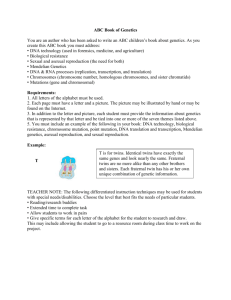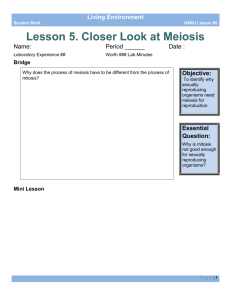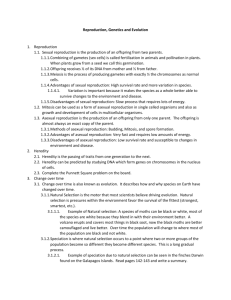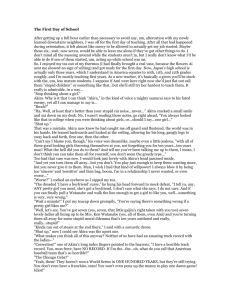Variation
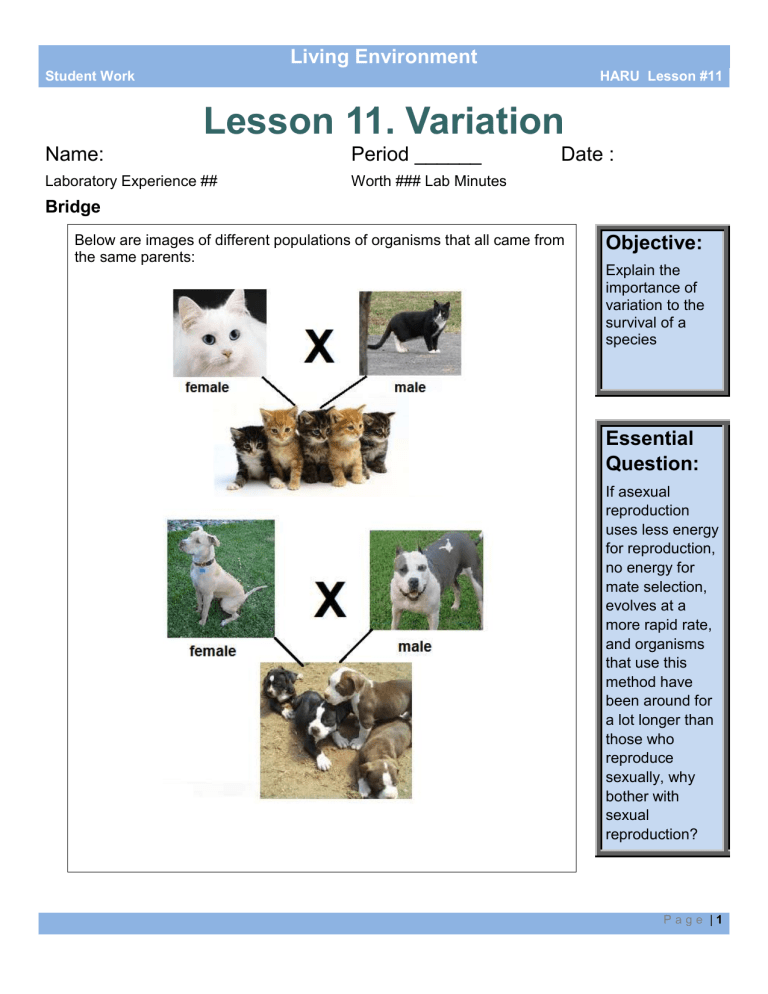
Student Work
Living Environment
HARU Lesson #11
Name:
Laboratory Experience ##
Bridge
Lesson 11. Variation
Period ______ Date :
Worth ### Lab Minutes
Below are images of different populations of organisms that all came from the same parents:
Objective:
Explain the importance of variation to the survival of a species
Essential
Question:
If asexual reproduction uses less energy for reproduction, no energy for mate selection, evolves at a more rapid rate, and organisms that use this method have been around for a lot longer than those who reproduce sexually, why bother with sexual reproduction?
P a g e | 1
Student Work
Living Environment
HARU Lesson #11
Why are none of the offspring the same as the parents?
Mini Lesson
Because chromosomes carry so many genes and there is a huge amount of different combinations that can come about AND because of recombination in meiosis a gamete in a sexually reproducing organism is never the same. That is why if you look in your own family your brothers or sisters may have characteristics that are very similar to you but not a single one of you looks exactly alike. This is because where your genes came from the same place, you will not have the exact same ones as your siblings. The same thing happens for all things in nature that reproduce sexually. It is these variations: different inborn immunities, different colorings, different heights, different length legs, different muscle strength in wings, that allow for some individuals in a population to survive in the face of environmental change while other individuals may die off.
The only exception to this rule is identical twins and even then there are very slight differences, enough that most people can tell them apart. But these differences come more from personality than their genetics.
Identical twins are formed when one egg is fertilized and starts to undergo mitosis. After several divisions, the cells that are dividing do not stay in blastocyst form as a ball of cells but rather a division will form two different blastocysts and two babies, that started off as the same cell, will begin to develop and grow. And since it is hormone and chemical interactions that tell the genes what to do during development, one may receive more of a signal than the other or not receive a signal at all, and slight differences in the gene expression may result.
Is it possible to have identical twins where one is a boy and one is a girl? Why or why not?
Fraternal twins are no more genetically alike than a brother and a sister. Fraternal twins will come when a woman releases 2 eggs instead of one during ovulation and both eggs manage to
P a g e | 2
Student Work
Living Environment
HARU Lesson #11 survive, implant into the uterus, and develop.
Is it possible to have fraternal twins that are the same sex? Different sexes? Why or why not?
Work Period
Based on the given “families”, predict what the offspring for your group of organisms may look like. Draw them out. Explain why your pictures are predictions and not givens. Use this activity to help you answer the EQ in the summary.
Summary
If asexual reproduction uses less energy for reproduction, no energy for mate selection, evolves at a more rapid rate, and organisms that use this method have been around for a lot longer than those who reproduce sexually, why bother with sexual reproduction?
Closing
If a new trait were to show up in an organism’s offspring, one that has never existed anywhere in the family tree before, what are the implications of that on future generations? What process is responsible for the emergence of this new trait?
P a g e | 3
Student Work
Name:
Independent Practice
Regents questions
Living Environment
Period ______ Date :
HARU Lesson #11
P a g e | 4
Student Work
Name:
Living Environment
Period ______ Date :
HARU Lesson #11
Title of Lab: ______________________________________________________
Exploration
Use this space to record observations that relate to the question being investigated. Also record researched facts that might relate to the investigation as well.
Question
Record your question that you will be investigating here. It is best to write it in a “Does
__________________ affect ________________? Format so the variables are easy to identify (first line is always the independent variable, second line is always the dependent variable)
Identify your Variables
Independent Variable:
Dependent Variable:
P a g e | 5
Student Work
Prediction/Hypothesis
Living Environment
HARU Lesson #11
Based on the question that you asked, record your thoughts on what the result will be and why. Use the “I think ___________________________________, because ______________.” format.
Experimental Design
List the materials that you are going to use and the procedure (steps) you are going to take to test your hypothesis.
Materials:
Procedure:
Data Collection
Use this space to organize and collect your data. Remember, data can be qualitative (descriptions, words, observations) as well as quantitative (numbers, values). Use both kinds of data when you can.
Organize your data into a table with a title, make a graph whenever you can, and use the variables to help you do this!
P a g e | 6
Student Work
Data Analysis
Living Environment
HARU Lesson #11
Put your data into words. This will be a relationship of your variables: what happened to the dependent variable when you changed the independent variable?
Evaluation
This is where you talk about your experiment. Discuss how your results compare to your hypothesis: do you agree or disagree with your original thoughts and use evidence from your experiment to back this up. Second, discuss sources of error (at least 2), or things that could have gone wrong in your experiment. Finally, develop a further investigation question: based on what you found out in this experiment, what else do you wonder about? Again, use your “Does ________ affect __________” format for this question.
P a g e | 7

